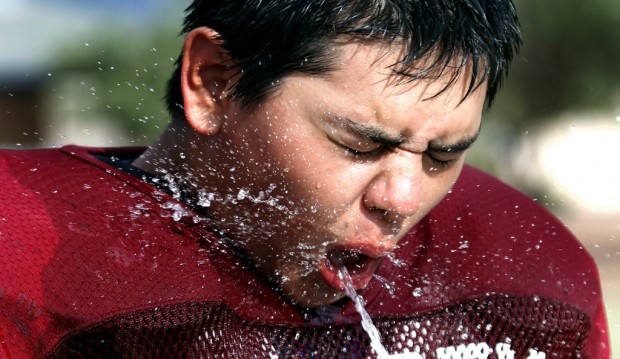
Picture this: it’s a Friday night. A wide receiver dashes across the middle of the field only to get crushed by a linebacker. The receiver is knocked cold, and a shocked silence falls over the crowd as a small cadre rushes out to him.
For the last four seasons, those first on the field have included Emily Ramos and Miranda Salazar, who have worked alongside longtime Sahuarita High athletic trainer Pete Morales as student athletic training aides.
These aspiring trainers are tasked with making sure athletes are stretched out, hydrated and in top shape during their games.
“I honestly cannot see myself being anything other than a trainer,” said Salazar, who has been in the program for three years. “I can’t see myself not being out working on a football field on a Friday night. I hope to take the knowledge that I learned through Mr. Morales’ class and apply it to my degree and on from there.”
Ramos and Salazar’s commitment to the training program has paid off; they’ve recently received academic scholarships to Northern Arizona University and the University of Arizona, respectively.
Ramos received a $38,000 scholarship in November to NAU, where she plans to major in sports medicine. Salazar received a $34,000 scholarship to study physiology at Arizona.
Ramos said her four years in the training program have given her a calling.
“I love the whole experience of it,” she said. “It’s really exciting on game nights, and it’s scary when someone gets hurt, but it’s also exciting for us as well.”
Morales said both girls are among the best and most hard-working students he’s had in his 20 years at SHS.
“I have no doubt that if athletic training is their career choice that they’re both going to be successful,” Morales said. “The sky’s the limit. I don’t like to say, ‘Oh, these are the greatest students I’ve ever had,’ because it’s not fair to the kids that were here before. But I can say that I’ve never had better.”
Learning from the best
Salazar and Ramos said they couldn’t have had a better mentor showing them the ropes.
“There aren’t enough good things to say about him,” Salazar said of Morales. “He’s just somebody you can always depend on, and he’ll go out of his way to make sure that you know what you’re doing. I’m going to start crying because I appreciate him so much, and I don’t tell him that enough. But it’s amazing to learn from someone like him.”
Ramos agreed with Salazar’s opinion of Morales, saying his plethora of experience has helped her immensely.
“He has an answer for everything,” Salazar said. “No matter what you ask him he’ll always have an answer. And I’ve pretty much come to him for anything — any problem I’ve had — whether it’s school-related or family-related, I can talk to him.”
A new world
Morales loves teaching students the ins-and-outs of athletic training because it opens a world that they never knew existed.
“The relationships these kids establish, not only with each other but with the athletes, is incredible,” Morales said. “The athletes appreciate them, the coaches appreciate them. And I guess that’s part of the draw to this program. They get these relationships that I don’t think they’d have otherwise.”
Salazar says she’s the prime example of how the program can affect one’s personality.
“I think for me it was just something refreshing,” Salazar said. “Because at the beginning of my freshman year I was very closed off and I didn’t really want to talk to people. I was afraid of the whole high school experience. And when I got here everyone welcomed me in and you grow a family bond here. It’s not even a friendship; it’s a big family.”
Ramos is hooked on athletic training, and said she knew it was the career field for her a few years ago.
“I’ve always enjoyed it, and I had the idea after my freshman year that this was something that I’d probably like to do,” Ramos said. “But I think the start of my junior year was when I was determined that this is what I’m passionate about. I want to continue doing it to the point where I couldn’t see myself doing anything else.”
Salazar has a similar goal for her life after college.
“I want to be the Mr. Morales of a school,” Salazar said. “I want to be a high school trainer.”
Christopher Boan | 547-9747
